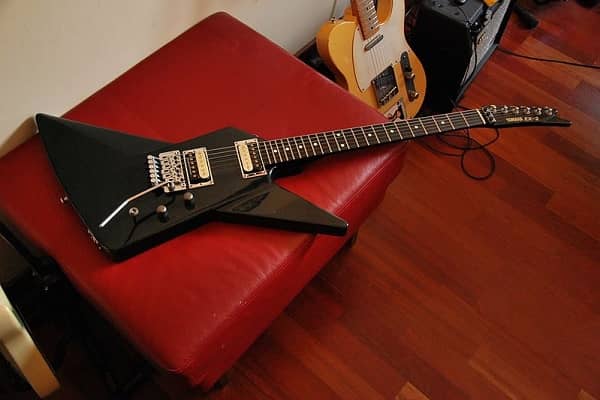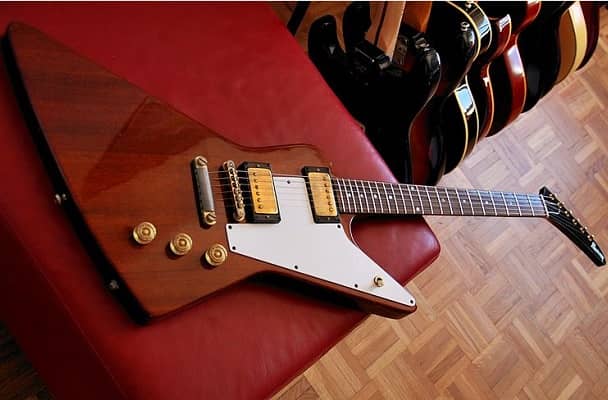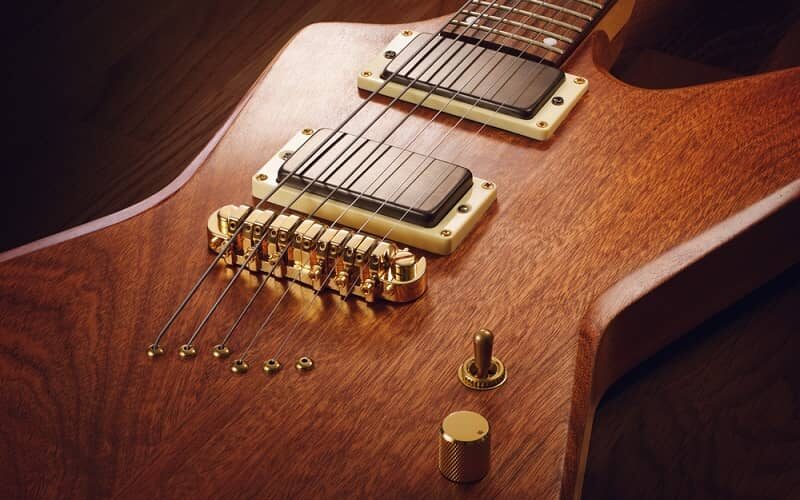Have you ever seen a picture of a pointy, spaceship-looking electric guitar and wondered…what IS that thing? Well, friend, you’re looking at the Gibson Explorer, one of the most legendary and iconic guitars in rock music!
When this funky, angular axe was unleashed in the late 1950s alongside its equally wacky sibling, the Flying V, it was utterly radical.
But over decades of being embraced by heavy rockers and metalheads, the Explorer Guitar became synonymous with attitude and aggro. Let’s drool over this radical piece of rock history together!
Origins and Design

Our epic journey starts back in 1958 when the Explorer burst onto the scene. This was a landmark year for music, seeing the rise of rock n’ roll thanks to Elvis and the dawn of Gibson’s Modernist series.
The Explorer and Flying V were part of Gibson President Ted McCarty’s vision to introduce radical new shapes inspired by the sci-fi future. The concept came from the “Googie architecture” trend of the 1940s and 50s which featured bold, angular design. Think space age diners with Sputniks on top!
These guitars were made from solid chunks of mahogany with set necks and dual humbucker pickups. This gave them a thick, beefy tone perfect for the new generation of rockers.
The original Explorer sported a 3-a-side headstock, later changed to the trademark “hockey stick” headstock which remains iconic today.
Despite its sasquatch body shape, the Explorer weighed under 10 pounds. Not exactly featherlight, but lighter than the dense Les Paul guitars Gibson was known for. The smooth pointed edges almost dared you to strap it on and shred!
When the Explorer was unveiled alongside the Flying V, it shocked the music world. Nothing like it had ever been seen before! But in 1958, it was a bit TOO radical for conservative guitar buyers. The initial Modernist series was a commercial flop and Gibson canned both models.
Thankfully, they reissued an improved version in the 1970s and the rest was history!
Sound and Playing Style
Once guitarists got past its bizarre shape, they realized the Explorer was built for rocking! Its solid mahogany body produced a thick, punchy tone with killer sustain perfect for high-gain distortion. The two humbuckers could be switched between series or parallel wiring using a 3-way toggle switch for further tonal variety.
The Explorer’s light weight is offset by the long upper fret access allowed by the pointed body shape. Shredders could blaze away on those high frets without hand strain. The design also moved more weight onto your fretting-hand shoulder for rhythmic stability.
Of course, comfort depends on your body type. The unorthodox Explorer shape affects ergonomics and weight balance. Players with larger hands may find its wider neck fits like a glove, while smaller folks could find it unwieldy.
Because of the strap button position, the guitar can shift heavily on your fretting shoulder and cause a neck dive. Ultimately it comes down to personal feel!
While requiring some technique adjustment, skilled rockers discovered the Explorer was built to wail. Its humbuckers delivered singing sustain perfect for soaring solos.
The tone was hot and fat, begging for overdrive and distortion pedals. Palm muting chords produced a deep, rhythmic throb. This thing was made for all your heavy riffing needs!
The Explorer in Music History
Despite underwhelming sales initially, the Explorer rose like a phoenix in the 1970s as heavy rock took flight. Bands like Aerosmith and AC/DC embraced this radical axe which suited their raucous sound.
But it was metal bands who truly latched onto the Explorer’s dark mystique. Young longhairs like Judas Priest and Iron Maiden wielded this weapon to conjure the demonic tones new extreme metal required.
Soon, Explorers were synonymous with aggression and volume. Thrash titans like Metallica and Slayer pushed the limits using Explorers to create their relentless rhythms and screaming leads. Their popularity exploded in the 80s as every metalhead yearned for the ultimate shredding machine.
Part of the appeal was the Explorer’s irreverent attitude. Neither Fender’s classy Strats or Gibson’s own elegantly-crafted Les Pauls could match its brutish charm. The Explorer became iconic simply for NOT being just another vintage-style guitar.
Modern metal bands like Avenged Sevenfold continue using Explorers for their menacing aesthetic. Likewise, hard rockers from ZZ Top to Foo Fighters lean on its raw rock power. Even after decades, aggressive players keep coming back to the Explorer’s enduring mojo.
Variants and Models

Given its popularity, Gibson and other brands have produced Explorer variants over the decades. Let’s check out some of the most famous!
Gibson’s Explorer is available today in both the Original and Modern Collections. The Original Collection aims to recreate vintage-accurate models in their 70s and 80s glory. These feature authentic materials like mahogany bodies and maple necks topped with rosewood fretboards.
Meanwhile, the Modern Collection adds contemporary updates like lighter chambered bodies and slimmer neck profiles. These include the Explorer B-2 finished in satin nitrocellulose lacquer.
Gibson has experimented with alternate materials over the years like maple, walnut or ebony finishes. Signature models were also made for artists like James Hetfield and Lzzy Hale. There’s even left-handed and bass versions for southpaws and low-end lovers!
Of course, Gibson’s design sparked countless imitators. Dean, BC Rich, Jackson and ESP all offer their own take on pointy Explorer-style guitars. While none match the mojo of an authentic 1958 Gibson Explorer, these copies satisfy shred heads on a budget!
Collectability and Notable Users
Given its rich history, vintage Explorers are highly collectible. It’s rare to find one of the few hundred original Korina wood 1958 models, which fetch astronomical prices at auction. But even 70s versions are coveted amongst collectors and players.
The Explorer is forever linked with rock legends who made it iconic. Tony Iommi crafted his muscular metal riffs using an SG Special and Explorer combo. Metallica’s James Hetfield spearheaded thrash with his white ESP Explorer customized with an “Eet Fuk” sticker.
Other famous players include Iron Maiden’s Dave Murray and his Jackson Randy Rhoads model, ZZ Top’s Billy Gibbons and his furry spinning Explorers, and Slash who wielded a flametop Les Paul and Explorer as Guns N’ Roses ruled the Sunset Strip.
Part of the appeal lies in how artists customize their Explorers with wild paint jobs and graphics reflecting their personalities.
Eddie Van Halen famously chopped down an Ibanez Destroyer which became the basis for his iconic “Frankenstein” guitar. Dave Grohl also used an Explorer to record Foo Fighters’ debut album, citing its “gnarly” tone.
In 2022, vintage 1958 Gibson Explorers can fetch over $250,000 at auction. But even without dropping a year’s salary, the Explorer remains an attainable dream. Owning this icon lets you tap into the rebellious rock spirit that birthed the legendary design over 60 years ago.
The radical Gibson Explorer has completed an epic rock n’ roll journey since its unveiled in 1958. From commercial failure to heavy metal icon, its angular body and gnarly tone have endured across generations. Today, the Explorer stands as one of the most recognizable and coveted guitars in the world.
Its brash attitude inspires players from bedroom shredders to stadium rockers. Pick one up and unleash your inner axe-wielding demon! While classifications and genres change, some things stay heavy.
The Explorer maintains its status as the ultimate weapon for aggressive music. Its legend continues to grow in the hands of new rock rebels.
So plug in, and make some noise, my friend!
About the Author
Team Guitar Top Review Talk about Guitars! We are a group of friends that bonded over their shared love of playing guitar. We all have different backgrounds and experiences with music, but we share a passion for writing about the things that we love.



